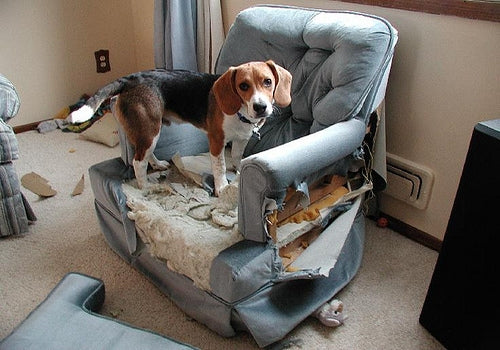Dogs are pack animals used to thrive in groups and not solitude even if it is an impermanent one that lasts only for a short duration and separation anxiety is a response to the fear that arises when the dog owner is away from the pet dog. It is an undesirable behavior that is suggestive of an inappropriate adjusting strategy as adopted by the canine. Not all dogs show symptoms of anxiety disorders. However if you return home only to find that the house-trained pet has urinated or defecated at different spots inside the house, or chewed on slippers/shoes/piece of furniture then consider the situation as one being critical.
Pets may resort to whining, barking or howling when alone. So you can always check with the neighbors if they heard persistent howling from your house. These are common symptoms of dog separation anxiety. Some pets may scratch the doors or exit points such as windows in a bid to dig and escape the lonely environment. Dogs are pack animals used to thrive in groups and not solitude even if it is an impermanent one that lasts only for a short duration. You may also notice that the dog follows you like a shadow when you are home. It may sense each time you are about to step out for work or pleasure.
All dogs have an instinctual affliction to anxiety , mostly in minor magnitudes, when separated from their master. Image Source - www.purina.com.au[/caption]
Once it’s known that the pet dog suffers from this undesirable disorder it becomes important to involve the veterinarian. He/she could prescribe certain medications that lessen the anxiety/panic in the dog.
Let’s take a look at the possible reasons for dog Separation anxiety
Factors such as lack of proper exercise and absence of healthy socialization from a young age increase the odds of developing separation anxiety. It is important to encourage your puppy to intermingle with other trained dogs as well as humans.
In a scenario where the dog is suddenly made to experience a different routine such as unexpectedly made to wait alone at home while you are away can cause such a disorder. A change in routine can cause panic as dogs like to follow a set pattern each day. Sometimes death of a family member can negatively affect the pet.
Measures you can adopt to deal with this dog behavioural problem
We have always stressed the importance of master donning the role of an effective and calm pack leader. A confident disposition on part of the dog owner will work towards calming the dog. You can familiarize your dog with a certain action of yours or can also use a word that helps you convey to the dog that all will be well when you are gone and that you will return to reunite.
Your action of leaving the house should seem like an ordinary one and not stand out. Try and seamlessly merge your exits or return to the house with the daily routine so that the pet dog does not consider all this to be something unusual. Start to ignore the dog 5 minutes or even more before your exit. Similarly after you arrive do not immediately show any king of affection such as petting the pooch, wait for at least five minutes. In some cases you may have to avoid any contact with the dog for upto an hour in order to deal with a case of high anxiety levels.
In case of Acute Seperation Anxiety dogs may even try to get away from the loneliness of confined houses by trying to breakthrough doors and windows of the house. Image Source - dynamicdogschicago.com[/caption]Your dog may feel close to you even when you are gone if you leave any garment of yours such as an used t-shirt/shirt that exudes your smell, hence helps keep the dog calm.
Another important step to help deal with the separation issues would be to slowly accustom the pet to being alone. Initially leave the dog alone for a much less amount of time. Gradually increase the time you are out of the house to evade problem behaviors in your canine. Do not suddenly expose the pet to a long period of absence of 8 hours or so.
Taking your dog out for a walk before one leaves for work is a good idea! It will help the pet enter a tranquil state where it would want to spend time resting, while you head out. Make sure you leave adequate dog food in its feeding bowl and top up the water bowl each time you depart.
Working towards ending the panic in your dog may involve approaches such as taking the help of a friend or relative who can come over at your place to look after the pet in your absence. Another possible solution could be leaving your dog at a neighbor’s place or a day-care/kennel for that specific period.
Never be harsh with your pet, always keep your cool and stay patient while treating separation anxiety disorder. Instead of keeping the dog in a crate, give it a secure room with its favorite treats and toys. Crating is not the ideal solution to prevent your dog from being destructive. Designate an airy/well lit space where the dog can busy itself with toys or feel secure with a piece of your clothing by its side. Isolating your dog within a crate may heighten the anxiety and it may also hurt itself in a bid to escape.
Some dog owners may want to bring a companion for their only pet. However this will not help the cause as the dog’s panicky reaction is more due to your absence and not entirely due to loneliness.
Always remember that such separation anxiety has nothing to do with disobedient behavior or associated training techniques. If your dog suffers from such a disorder it doesn’t mean it is disobedient.

